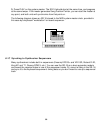
59
8.2 STRATEGIES FOR ASSEMBLING PATTERNS AND SONGS
Ideally, you should be able to translate your inspirations into tangible form with a minimum
amount of effort. The following tips and techniques help speed up the process of creating
Patterns and Songs.
8.2A Create Fills Quickly with the Copy Function
Many times a Fill will simply be a variation on another Pattern, but with a few minor
differences to add variety or serve different musical purposes. To save time, use the Copy
function to copy the main Pattern to the Fill, then add variations to the Fill in real time or with
Step Edit mode.
8.2B Assemble Short Patterns into Longer Patterns with the Copy Function
It's less time-consuming to work with short Patterns, since you don't have to wait for the entire
Pattern to cycle through before overdubbing or "spot erasing" events. After assembling
several short Patterns, use the copy function to append Patterns into a longer Pattern.
Example: Create four eight-beat Patterns, then use the copy function to combine these into a
single 32-beat Pattern.
8.2C Save Memory Through Song Steps
Whenever possible, repeat Patterns using Song steps rather than program long Patterns.
Example: Suppose you have a 16-measure figure where the first three groups of four
measures are identical, and the final group of four measures provides some sort of variation.
Recording this as one 16-measure Pattern will take up more memory than recording two
Patterns (one of the first group of four measures and one of the last group of four measures),
and while in Song mode repeating the first group three times followed by the last group once.
8.2D Odd Time Signatures
For time signatures based on quarter notes, changing the number of beats in a Pattern can
also change the time signature. Example: Programming a Pattern length seven beats long
will yield a measure of 7/4. Programming a Pattern length 14 beats long will yield two
measures of 7/4. Time signatures such as 2/4, 3/4, 5/4, 9/4, and so on are easy to implement.
For time signatures based on eighth notes, it's easiest to double the tempo so that each beat
lasts an eighth note instead of a quarter note. However, you will have to take this into account
when quantizing and setting the metronome—if the display says a quarter note, read it as an
eighth note.
Plan carefully when mixing odd time signatures within the same piece. If some Patterns use a
time signature based on quarter notes and others on eighth notes, you will need to double
the tempo for the quarter note-based Patterns to match up with the eighth-note based
Patterns.


















